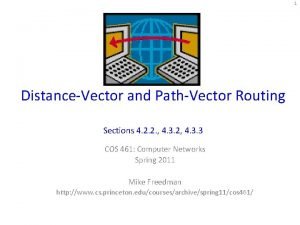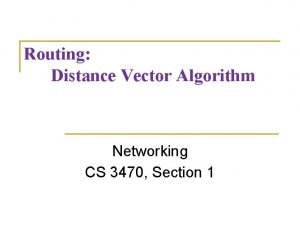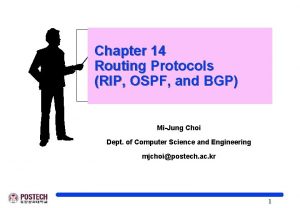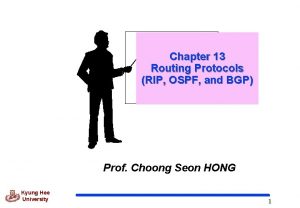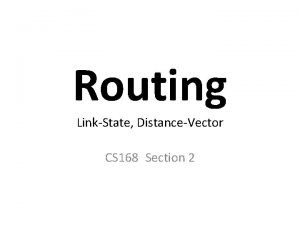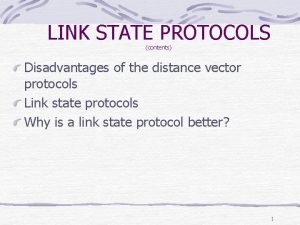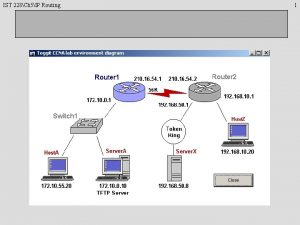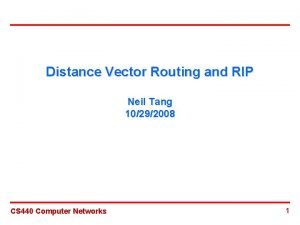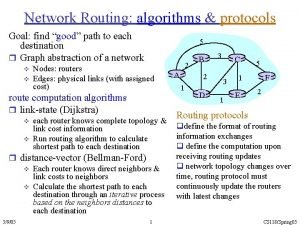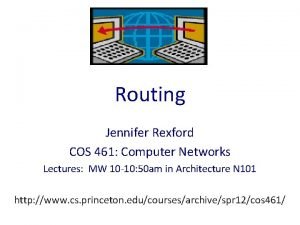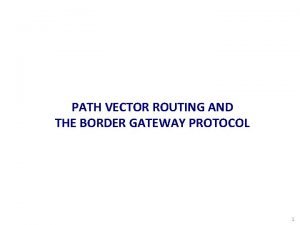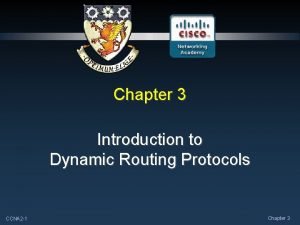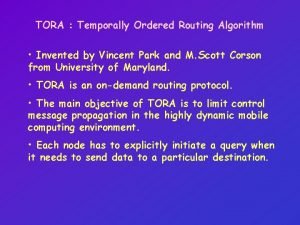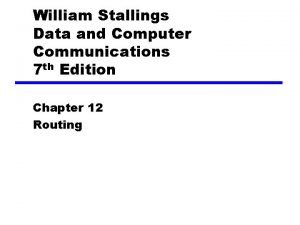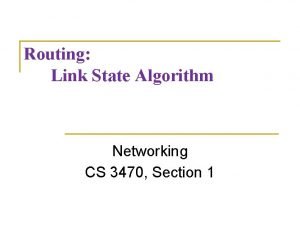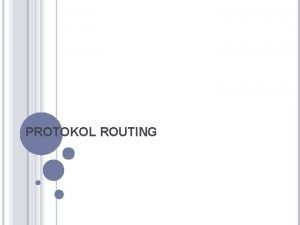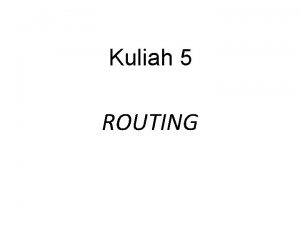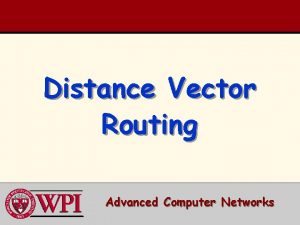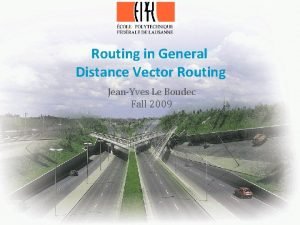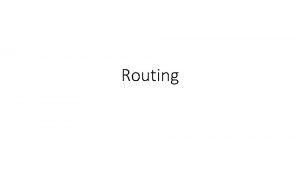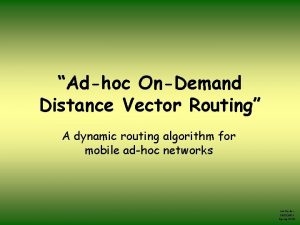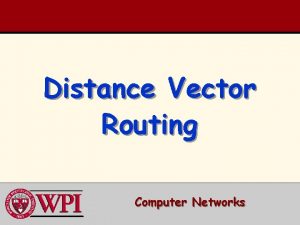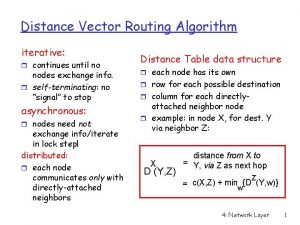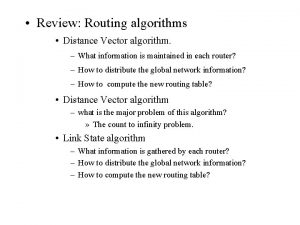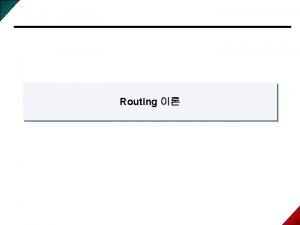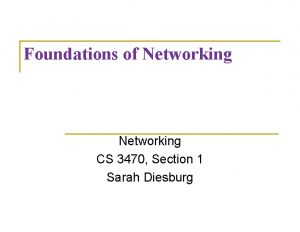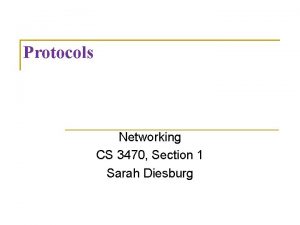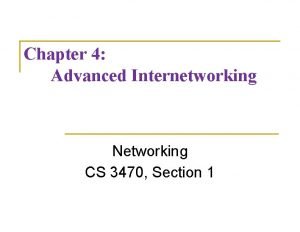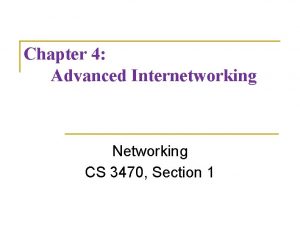Routing Distance Vector Algorithm Networking CS 3470 Section
























- Slides: 24

Routing: Distance Vector Algorithm Networking CS 3470, Section 1

Review So how is routing different from forwarding?

Routing Network as a Graph 5 2 A 2 1 B D 3 C 3 1 5 F 1 E 2 The basic problem of routing is to find the lowest -cost path between any two nodes Where the cost of a path equals the sum of the costs of all the edges that make up the path

Routing protocols need to be both dynamic and distributed Deal with node and link failures, changing link costs, and scalability 4

Distributed Routing Algorithms Two standard distributed routing algorithms Link state routing Distance vector routing What link state routing protocol did we discuss last time? 5

Link State vs Distance Vector Both assume that Both find global information The address of each neighbor is known The cost of reaching each neighbor is known By exchanging routing info among neighbors Differ in info exchanged and route computation LS: tells every other node its distance to neighbors DV: tells neighbors its distance to every other node 6

Distance Vector Routing A router tells neighbors its distance to every router Communication between neighbors only Each router maintains a distance table A row for each possible destination A column for each neighbor DX(Y, Z) : distance from X to Y via Z 7

Distance Vector Routing Given a distance table we can find the shortest distance to a destination A list of <destination, shortest distance> tuples is called a distance vector i. e. , the smallest value in the row corresponding to the destination. Current least cost to each destination Exchanged between neighbors Based on Bellman-Ford algorithm Computes “shortest paths” 8

Distance Table: Example Distance table at router E E A E 2 A B D A 1 14 5 B 7 8 5 C 6 9 4 D 4 11 2 C 2 8 1 1 D () D destination 7 B cost to destination via If E were to advertise its distance vector, it would send <A, 1>, <B, 5>, <C, 4>, <D, 2> 9

Distance Table to Routing Table cost to destination via A B D A 1 14 5 B 7 8 5 destination D () C 6 D 4 9 11 4 2 Distance table Outgoing link to use, cost destination E A A, 1 B D, 5 C D, 4 D D, 2 Routing table 10

Distance Vector Routing Algorithm Now the real question… How do we compute this distance table? That’s where we use Bellman-Ford algorithm. 11

Distance Vector Routing Algorithm iterative: continues until no nodes exchange info. self-terminating: no “signal” to stop Distance Table data structure each node has its own row for each possible destination column for each directly-attached neighbor to node example: in node X, for dest. Y via neighbor Z: asynchronous: nodes need not exchange info/iterate in lock step! distributed: each node talks only with directly-attached neighbors X D (Y, Z) distance from X to = Y, via Z as next hop Z = c(X, Z) + minw{D (Y, w)} 12

Distance Vector Routing: Overview Iterative, asynchronous: Each node: each iteration caused by: local link cost change message from neighbor: its least cost path change from neighbor Distributed: each node notifies neighbors only when its least cost path to any destination changes neighbors then notify their neighbors if necessary wait for (change in local link cost or msg from neighbor) recompute distance table if least cost path to any dest has changed, notify neighbors 13

Distance Vector Algorithm: Example 2 X Y 7 1 Z Z X D (Y, Z) = c(X, Z) + minw {D (Y, w)} = 7+1 = 8 Y X D (Z, Y) = c(X, Y) + minw {D (Z, w)} = 2+1 = 3 14

Distance Vector Algorithm: Example 2 X Y 7 1 Z 15

Distance Vector Algorithm: Example 2 X Y 7 1 Z 16

Convergence of DV Routing router detects local link cost change updates distance table if cost change in least cost path, notify neighbors “good news travels fast” 1 4 X Y 50 1 Z algorithm terminates 17

Problems with DV Routing Link cost changes: good news travels fast bad news travels slow “count to infinity” problem! 60 4 X Y 50 1 Z algorithm continues on! 18

Fixes to Count-to-Infinity Problem Split horizon A router never advertises the cost of a destination to a neighbor If this neighbor is the next hop to that destination Split horizon with poisonous reverse If X routes traffic to Z via Y, then X tells Y that its distance to Z is infinity Instead of not telling anything at all Accelerates convergence 19

Split Horizon with Poisoned Reverse If Z routes through Y to get to X : Z tells Y its (Z’s) distance to X is infinite (so Y won’t route to X via Z) 60 4 X Y 50 1 Z algorithm terminates 20

Count-to-Infinity Problem X Y Z W What happens when the link Y to Z goes down? All three routers X, Y, and W together count to infinity. Split horizon solution works only when two routers are involved in a loop. 21

Count-to-Infinity Problem X Y Z W To completely eliminate the problem, a router some how need to figure out the complete path to a destination. Obvious solution is to pass on the path information along with the distance vector. This path vector approach is used in BGP. 22

Link State vs Distance Vector Tells everyone about neighbors Tells neighbors about everyone Controlled flooding to exchange link state Exchanges distance vectors with neighbors Dijkstra’s algorithm Bellman-Ford algorithm Each router computes its own table Each router’s table is used by others May have oscillations May have routing loops 23

RIP == Routing Information Protocol RIP is a distance vector implementation (network_address, distance) pairs Instead of advertising costs to the next router, RIP advertises the cost to the next network.
 Routing sections
Routing sections Vector algorithm
Vector algorithm Distance-vector routing
Distance-vector routing Rip ospf bgp
Rip ospf bgp Pengertian link state
Pengertian link state Advantages and disadvantages of distance vector routing
Advantages and disadvantages of distance vector routing Distance vector routing
Distance vector routing Distance vector routing
Distance vector routing Three dumb routers
Three dumb routers Distance vector algorithm
Distance vector algorithm Vertical line in html
Vertical line in html Static routing and dynamic routing
Static routing and dynamic routing Hydrologic continuity equation
Hydrologic continuity equation Clock skew
Clock skew Path vector routing
Path vector routing Path vector routing
Path vector routing Ccna 2 chapter 3
Ccna 2 chapter 3 Ppdioo
Ppdioo Tora algorithm
Tora algorithm Least cost routing algorithm
Least cost routing algorithm Unit vector
Unit vector Vector
Vector Resolution of vectors
Resolution of vectors Define position vectors
Define position vectors Tora
Tora
